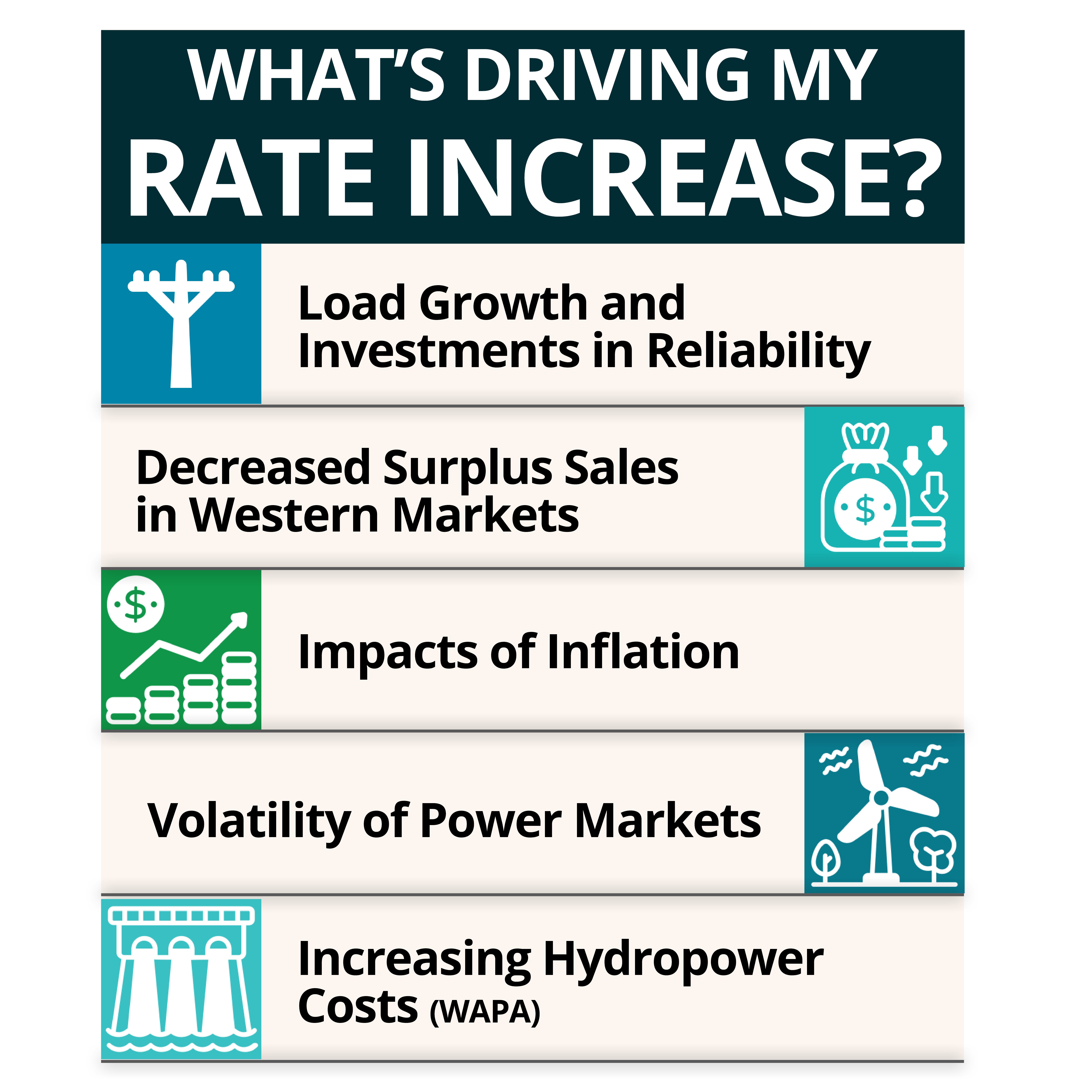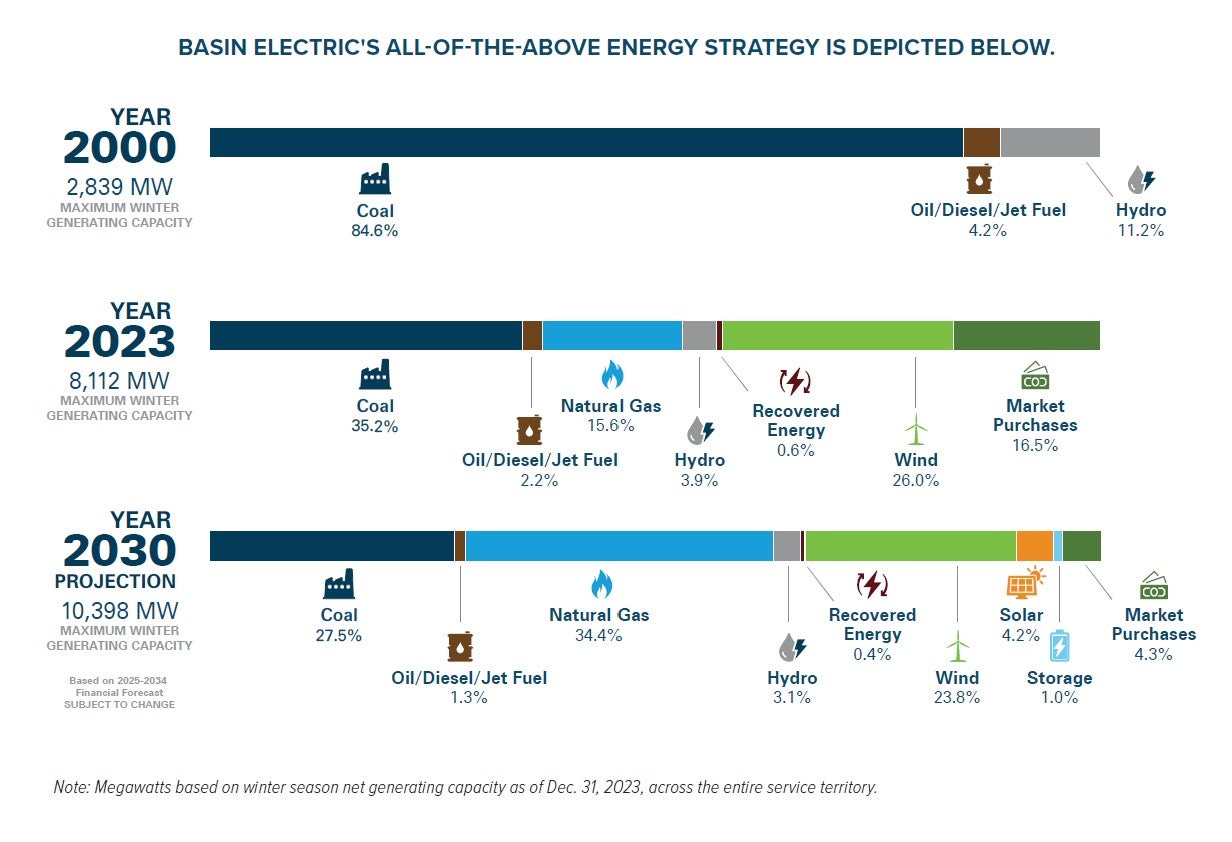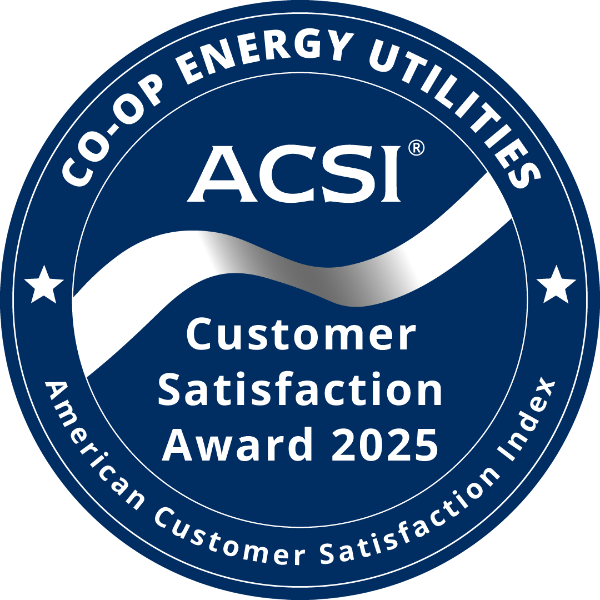2025 Rate Change
Due to higher power supply costs, the Sioux Valley Energy Board approved an overall average increase of 4.9% as of January 1, 2025. Members will see the rate change on their February billing, which reflects January energy usage. Rate adjustment percentages will vary depending on members' specific energy (kWh) usage. Click HERE to see the 2025 Rates.
Power supply costs account for more than 60% of Sioux Valley Energy’s expenses. Sioux Valley Energy’s wholesale power supplier, Basin Electric Power Cooperative, has announced an approximate 7% increase for the coming year. Additionally, the Western Area Power Administration (WAPA) has announced a nearly 14% rate increase over two years.
Learn more from Sioux Valley Energy’s GM/CEO Tim McCarthy in his December Manager Message Video below:
Sioux Valley Energy’s power supply costs will increase by 7.6% in 2025. Any power supply increase is passed directly through to the member. The reason power supply rates are so impactful is because approximately 60% of SVE’s costs come from power supply. Last year most of the rate increase stemmed from higher distribution costs – things like costs of materials, equipment, services, billing, labor, financing, etc.

Basin Electric Power Cooperative's increase is driven by the following factors:
1. Load Growth and Investments in Reliability: Basin Electric is making significant investments in new generation and transmission facilities to support member load growth across its entire system, and it’s critical to invest in existing facilities to maintain reliability. To accommodate this growth, Basin Electric is investing approximately $8 billion over the next 10 years in transmission and generation assets to ensure reliable electricity for our members.
2. Decreased Surplus Sales in Western Markets: Market dynamics have been impacted by changes in the generating fleet in the western part of the United States. Increasing amounts of hydro and renewable energy generated in the western market are often lower priced than what our wholesale power supplier (Basin Electric) can produce it for. This limits Basin Electric’s ability to sell excess generation to the western markets.
3. Impacts of Inflation: There have been cost increases for internal labor, contracted labor, materials, and maintenance, in addition to higher costs of borrowing money (higher interest rates) and increased insurance premiums.
4. Volatility of Power Markets: Power markets have become more volatile, resulting in dramatic price movements. Increasing intermittent generation such as wind and solar, swings in natural gas prices, and increasing electricity demand are primary contributors to volatility. While this is managed through generation and hedging, the cost of this is increasing.
Here at home, Sioux Valley Energy has also been facing upward pressure on the cost of materials, equipment, labor, and financing.
The Western Area Power Administration (WAPA) increase is driven by the following factors:
5. Increasing Hydropower Costs: As for the Western Area Power Administration (WAPA), the top reason for the rate increase is drought. Dams and hydropower facilities did not generate enough power due to drought, which forced WAPA to purchase power to meet its obligations. It is also dealing with increased operation and maintenance costs for things like material and labor.
- Sioux Valley Energy has several programs and special rates that may help you save. Learn more here.
- Want to make your home or business more efficient, check out these resources:
- Struggling to pay your electric bill? There are many assistance agencies available for members. You can find the agency listing here.
Farm and Rural Residential
If a single-phase farm and rural residential member uses 1,500 kWh a month, their monthly electric bill will increase $10.50 a month or $126 a year.
|
Rate Component |
Old Rate |
New Rate |
|
Single-Phase Basic Service Charge |
$65 |
$65 |
|
Three-Phase Basic Service Charge |
$120 |
$120 |
|
Energy Charge |
$0.1055 |
$0.11250 |
Residential
If a residential member uses 1,200 kWh a month, their monthly electric bill will increase $8.40 a month or $100.80 a year.
|
Rate Component |
Old Rate |
New Rate |
|
Basic Service Charge |
$30 |
$30 |
|
Energy Charge |
$0.1055 |
$0.11250 |
General service
|
Rate Component |
Old Rate |
New Rate |
|
Single-Phase Basic Service Charge |
$75 |
$75 |
|
Three-Phase Basic Service Charge |
$120 |
$120 |
|
Energy Charge |
$0.1055 |
$0.11250 |
Large Power
|
Rate Component |
Old Rate |
New Rate |
|
Basic Service Charge |
$1.50/kVA |
$1.50/kVA |
|
Demand Charge |
$17.00/kW |
$17.50/kW |
|
Energy Charge |
$0.03760/kWh |
$0.04110/kWh |
This fee helps pay for the electrical infrastructure (poles, wires, transformers, substations, etc.) that is required to get power to your home or business. It also helps pay for the maintenance of that equipment. There is a fixed cost for the infrastructure regardless of how much electricity you use (even if you use 0 kWh there is a fixed cost to have the service at your location). The average investment per account is approximately $12,500 plus ongoing maintenance costs.
If a single-phase farm and rural residential member uses 1,500 kWh a month, their monthly electric bill will increase $10.50 a month or $126 a year.
If a residential member uses 1,200 kWh a month, their monthly electric bill will increase $8.40 a month or $100.80 a year.
Sioux Valley Energy raised its rates in 2024, prior to that the last increase occurred in 2020. Sioux Valley Energy is having to increase rates in 2025 due to higher power supply costs which are passed directly back to the member. The Cooperative was able to reduce its direct expenses. These costs include day to day activities such as cable locating, right-of-way clearing, pole testing, member billing and postage, member meetings, community development, software, director expenses, building expenses, dues, and outside services.
Each utility has its own method of recovering the cost of providing electricity to its customers. According to the US Energy Information Administration (EIA) as of July 2024 the average cost for electricity in the U.S. was 16.63 cents/kWh. The average cost for Minnesota residents was 16.33 cents/kWh and the average for South Dakota residents was 13.85 cents/kWh. With the increase, SVE’s average residential rate (including basic service charge) is 13.59 cents/kWh. This analysis shows that Sioux Valley Energy is less than the average rate in South Dakota and significantly lower than the average rate in Minnesota. https://www.eia.gov/state/data.php?sid=SD
https://www.eia.gov/state/data.php?sid=MN
The Cooperative is a not-for-profit electric utility. Our business model focuses on setting rates based on actual costs – profit is not the focus. In fact, any margin that is realized by the Cooperative is given back to the members in the form of capital credits. We are, however, required by lenders to maintain minimum financial benchmarks.
To minimize the need for a rate increase, we reviewed all expenses and were able to decrease direct expenses in 2025. However, because direct expenses only make up 6% of the budget, the impact of that is minimal. The driving force behind the rate adjustment is power supply costs (61% of the budget), which are not controllable expenses. Direct expenses include day to day activities such as cable locating, right-of-way clearing, pole testing, member billing and postage, member meetings, community development, software, director expenses, building expenses, dues, and outside services.
There is a cost to the Brandon building. However, the rate impact is minimal because this is a capitalized expense and is spread out over a time period of 50 years, so both existing and future members pay for it. This expansion is necessary to prepare the Cooperative to serve its members well into the future. The capitalized expense of the Brandon building expansion did not impact the decision to increase rates in 2025 because that increase is attributable to power supply costs.
On an average $120 electric bill, approximately 91 cents will go towards the Brandon building expansion. That is three-quarters of one percent (0.76%) of your electric bill.
- Sioux Valley Energy has several programs and special rates that may help you save. Learn more here.
- Want to make your home or business more efficient, check out these resources:
- Struggling to pay your electric bill? There are many assistance agencies available for members. You can find the agency listing here.
There are many ways you can lower your electric use. Here are some great ways you can save:
The answer to this question is “probably”. Our power wholesale power supplier, Basin Electric has indicated they will need to increase their rates in 2026 as well. In addition, the Western Area Power Administration (WAPA) will have at least one more year of rate increases in 2026.
Power generation is not as simple as building a few power plants, turning on the switch, and sending electricity through the grid to power homes and businesses. Power suppliers must plan years (sometimes decades) in advance to successfully add generating resources to their fleet. They also need to factor in federal, state, and local regulations and policies to construct new facilities. In addition, public acceptance is also a consideration as it becomes more and more challenging to site and build infrastructure needed to provide reliable electricity to all members.
To help answer common member questions, we developed the following information. Power generation is a complex issue – we hope this document helps paint a picture of the intricacies of the electrical system, how it impacts your rates and what it takes to ensure reliability into the future.
Sioux Valley Energy does not generate electricity and does not decide which types of generation to build. However, its power supplier is building natural gas-fired generation and adding new transmission assets to the electric system.
To explain, the electric co-op system in this area is divided into three tiers – generation, transmission, and distribution. Sioux Valley Energy serves as the distributor, delivering electricity directly to its end members. Its power suppliers, East River Electric and L&O Power Cooperative, manage the transmission tier, while Basin Electric Power Cooperative (Basin Electric) generates electricity from a diverse energy mix. Additionally, the Western Area Power Administration contributes hydropower generated from dams on the Missouri River.
Sioux Valley Energy has what is called an “all requirements” contract with its power suppliers, which means the Cooperative must purchase all its power from its power suppliers. The only caveat to the “all requirements contract” is Sioux Valley Energy’s solar demonstration projects and individual members who produce their own power at their home or business through small-scale renewable energy systems. There are limitations on the size of those systems, however.
Sioux Valley Energy owns two solar arrays that produce a small amount of electricity – a community solar array near its Colman headquarters and a demonstration solar array at its Brandon facility. Both solar arrays are small-scale demonstration projects that are not meant to produce a significant amount of electricity.
Sioux Valley Energy supports an “all of the above” energy generation strategy as the most prudent and effective approach. This strategy ensures a diversified energy mix, avoiding reliance on a single source or “putting all our eggs in one basket.”
It is essential to have baseload generation (24/7 power) as the powerhouse of the generating fleet. Traditionally, this role has been filled by coal. But as the political and regulatory landscape has shifted, so has the approach to the construction of new generation.
Coal still makes up just over 35% of Sioux Valley Energy’s wholesale power supplier’s (Basin Electric Power Cooperative) power-generating fleet. Coal remains an important part of the equation and provides a reliable source of power through a fuel source that can be stored or mined near the generator. Natural gas is the most economical dispatchable power generation to finance, permit, and operate. Renewables such as wind and solar do fill a need in power generation even though they are intermittent (do not run 24/7). Depending on the weather conditions across our region, wind can meet as much as 80% or more of our total power supply needs on a given day. But if the wind isn’t blowing across a large portion of our region, it could provide 1% or less of our power supply needs. Wind and solar work very well when matched with natural gas. This is because natural gas plants can quickly change the output to match the variability or intermittency of wind and solar. At the end of 2023, renewable generation made up over 30% of Basin Electric’s energy portfolio, which includes wind and hydro.
As new baseload generation is built, the focus has shifted to natural gas due to its ability to provide reliable and affordable energy. Sioux Valley Energy’s wholesale power supplier is planning to construct two additional natural gas resources in the next five years to meet future energy needs. Because of regulatory and political pressures on coal, they are leaning towards natural gas as the most viable source for reliable generation. Factors such as public education and the complexities of the siting and approval process are being carefully navigated to advance these projects successfully. New baseload generation HAS to be built because the demand for electricity is increasing and there is a need for both baseload generation and renewable generation to fill that void. This presents an opportunity to invest in modern, highly efficient power plants that will provide reliable energy for years to come, ensuring continued service to our members.

The chart above shows how its power generation portfolio has changed over the years and what is being planned for the future. You can find some great information in Basin Electric’s Sustainability Report found here: https://www.basinelectric.com/_files/pdf/financials/ Sustainability-Report-November-2024.pdf
Renewable energy, such as wind and solar, are an important part of the “all of the above” power supply strategy mentioned earlier. These resources are intermittent, which means they do not run 24/7. Baseload-generating resources such as natural gas and coal run 24/7 and are the backbone of reliability for electric co-ops.
Costs for wholesale power are increasing. Sioux Valley Energy’s wholesale power suppliers, Basin Electric and the Western Area Power Administration (WAPA), have increased their rates in 2025. For Basin Electric, factors for the increase include inflation, higher equipment and maintenance costs, and additional investments in generation and transmission to meet a growing demand for electricity. For WAPA, increased operations and maintenance costs, along with drought, were the impacting factors for the power supply cost increase.
Basin Electric currently owns or purchases power from more than 20 various wind facilities in North Dakota, South Dakota, and Minnesota. None of those wind facilities are located within Sioux Valley Energy’s service territory. Basin Electric purchases power from one solar facility located in Pennington County, South Dakota, as well as some recovered energy generation along the Northern Border Pipeline.
Sioux Valley Energy does not push members to convert to electric technologies. However, we are increasingly fielding inquiries and requests for beneficial electrification programs from our membership, and we are responding to those needs. Electric technologies provide consumers with desirable attributes such as quiet operation, zero emissions, minimal maintenance, and ease of use, which are driving the interest in those technologies. Our role is to educate members by providing factual information on electrification and develop programs that incentivize off-peak electric use and charging. This is beneficial to all members by helping to control demand costs for the Cooperative.
Rate Calculator
Want to know what your electric bill will be with the new rates? Click on the button below to calculate the following rates: Residential, Farm & Rural Residential, and Electric Heat.
Components of Your Energy Costs
- There will not be an increase to the basic service charge.
- There will be an increase to the energy charge for most rate classes.
- Demand charge will increase for large power members.
Want to learn more?
Check out these videos featuring Tim McCarthy, GM/CEO
Load growth and investment
Power Supply Costs Increasing
Where Your Electric Dollars Go
Power Supply Rate Pressures


